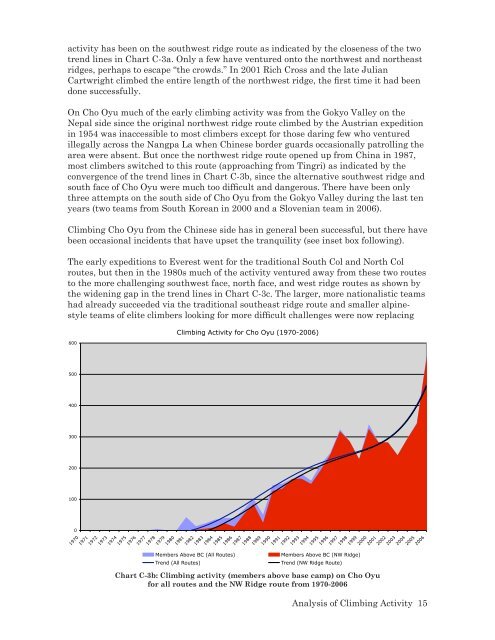The Himalaya by the Numbers: A Statistical Analysis - Himalayan ...
The Himalaya by the Numbers: A Statistical Analysis - Himalayan ...
The Himalaya by the Numbers: A Statistical Analysis - Himalayan ...
Create successful ePaper yourself
Turn your PDF publications into a flip-book with our unique Google optimized e-Paper software.
activity has been on <strong>the</strong> south west ridge route as indicated <strong>by</strong> <strong>the</strong> closeness of <strong>the</strong> two<br />
trend lines in Chart C-3a. Only a few have ventured onto <strong>the</strong> northwest and nor<strong>the</strong>ast<br />
ridges, perhaps to escape “<strong>the</strong> crowds.” In 2001 Rich Cross and <strong>the</strong> late Julian<br />
Cartwright climbed <strong>the</strong> entire length of <strong>the</strong> northwest ridge, <strong>the</strong> first time it had been<br />
done successfully.<br />
On Cho Oyu much of <strong>the</strong> early climbing activity was from <strong>the</strong> Gokyo Valley on <strong>the</strong><br />
Nepal side since <strong>the</strong> original northwest ridge route climbed <strong>by</strong> <strong>the</strong> Austrian expedition<br />
in 1954 was inaccessible to most climbers except for those daring few who ventured<br />
illegally across <strong>the</strong> Nangpa La when Chinese border guards occasionally patrolling <strong>the</strong><br />
area were absent. But once <strong>the</strong> northwest ridge route opened up from China in 1987,<br />
most climbers switched to this route (approach ing from Tingri) as indicated <strong>by</strong> <strong>the</strong><br />
convergence of <strong>the</strong> trend lines in Chart C-3b, since <strong>the</strong> alternative southwest ridge and<br />
south face of Cho Oyu were much too difficult and dangerous. <strong>The</strong>re have been only<br />
three attempts on <strong>the</strong> south side of Cho Oyu from <strong>the</strong> Gokyo Valley during <strong>the</strong> last ten<br />
years (two teams from South Korean in 2000 and a Slovenian team in 2006).<br />
Climbing Cho Oyu from <strong>the</strong> Chinese side has in general been successful, but <strong>the</strong>re have<br />
been occasional incidents that have upset <strong>the</strong> tranquility (see inset box following).<br />
<strong>The</strong> early expeditions to Everest went for <strong>the</strong> traditional South Col and North Col<br />
routes, but <strong>the</strong>n in <strong>the</strong> 1980s much of <strong>the</strong> activity ventured away from <strong>the</strong>se two routes<br />
to <strong>the</strong> more challenging southwest face, north face, and west ridge routes as shown <strong>by</strong><br />
<strong>the</strong> widening gap in <strong>the</strong> trend lines in Chart C-3c. <strong>The</strong> larger, more nationalistic teams<br />
had already succeeded via <strong>the</strong> traditional sou<strong>the</strong>ast ridge route and smaller alpinestyle<br />
teams of elite climbers looking for more difficult challenges were now replacing<br />
600<br />
500<br />
400<br />
300<br />
200<br />
100<br />
0<br />
1970<br />
1971<br />
1972<br />
1973<br />
1974<br />
1975<br />
1976<br />
1977<br />
1978<br />
1979<br />
1980<br />
Climbing Activity for Cho Oyu (1970-2006)<br />
1981<br />
1982<br />
1983<br />
1984<br />
1985<br />
1986<br />
1987<br />
1988<br />
1989<br />
1990<br />
1991<br />
1992<br />
1993<br />
1994<br />
1995<br />
1996<br />
1997<br />
1998<br />
Members Above BC (All Routes) Members Above BC (NW Ridge)<br />
Trend (All Routes) Trend (NW Ridge Route)<br />
Chart C-3b: Climbing activity (members above base camp) on Cho Oyu<br />
for all routes and <strong>the</strong> NW Ridge route from 1970-2006<br />
1999<br />
2000<br />
2001<br />
2002<br />
2003<br />
2004<br />
2005<br />
2006<br />
<strong>Analysis</strong> of Climbing Activity 15


